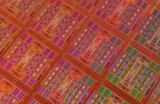
With 193 nm water immersion lithography being further extended through double and multiple exposure approaches to extend the pattern frequency, extreme ultraviolet (EUV) lithography is also a next-generation technology candidate in the roadmap, however EUV is limited by expensive, difficult to maintain tools and equipment, and lack of commercial systems that have gained industry acceptance. As a result the Semiconductor Research Corporation (SRC) and Sematech have jointly supported a directed self-assembly project to evaluate the performance of DSA and consider approaches for transitioning the technique from laboratory research programs. The goal of the program is to explore the application of DSA techniques to CMOS technology using NIL-patterned 300mm wafers in order to both demonstrate large scale wafer application and quantify defectivity and process capabilities. While various approaches to DSA have been reported in the literature, including field and surface assisted assembly, the predominant method utilizes physical structures pre-patterned on a surface to relegate the assembly of polymer blend. By controlling the properties of the polymer blend, the initial pattern features and density, and the adjacent surface properties, control of the directed assembly pattern multiplication, fidelity, and morphology can be achieved. In this manner, resists and polymer blends could be developed which would extend the existing 193 nm immersion lithography infrastructure while the next-generationoptical or imprint lithography tools are being developed and refined.
The project supported by SRC/Sematech seeks to validate and demonstrate the state of DSA techniques for the semiconductor industry in order to establish the necessary standards and design rules to broadly transition DSA to manufacturing platforms. DSA has already demonstrated the ability to assemble a range of essential geometries and features, but further assessment is necessary to evaluate the critical parameters in a pre-manufacturing context. As such, key research metrics have been specified as part of the outcome of this program, including defectivity, pattern line edge roughness (LER), control of gate critical dimensions, essential shapes, overlay and registration, mean throughput, etch and pattern transfer, placement and orientation, ability to generate multiple dimensions per layer, ease of integration, and compatibility with existing chemically amplified resist processing. As the block copolymer blends anticipated for this application will likely remain expensive, cost may be a further consideration.
Through this joint program, DSA approaches have a good opportunity to be validated for integration with semiconductor manufacturing processes. The key to gaining acceptance from the industry will be defining essential parameters that must be achieved for the new process techniques. While these parameters have emerged for ITRS, the nanomanufacturing community seeks input from stakeholders in other industry and product sectors as to specific needs and limitations for existing approaches. Ideally this would establish additional programs to validate emerging tools, processes, and materials to advance the roadmaps of these industries.
This work is licensed under a Creative Commons Attribution-NonCommercial 3.0 Unported.
